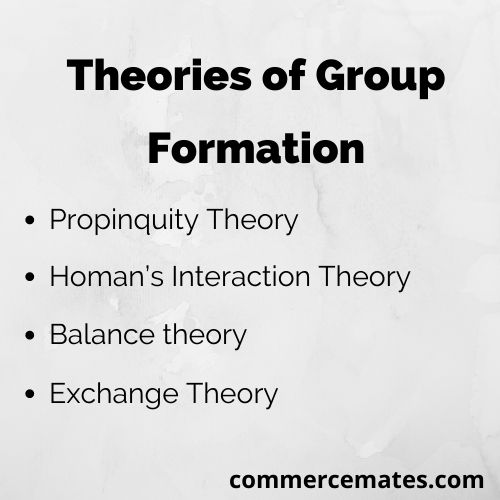Contents
Meaning of Group Formation
Formation of the group simply means two or more persons came together for working toward the achievement of the same goals and objectives. Group creation enables the performance of difficult tasks easy and efficient. It enables sharing of a wide range of knowledge and experiences of numerous people working in a group which will helps in the formulation of better plans.
All people working as group have defined roles and are interdependent on each other. Performance of each member will affect the performance of entire group. There are group leaders in each group who monitors and allot duties to each member. Leader also takes suggestion from their members and is responsible for maintaining the cooperation and peace within the group members. Group formation is also known as termed as team development or team building.
Bruce Tuckman was the person who proposed model of group formation that includes various stages viz. forming, storming, norming, performing and adjourning. There are several theories which explain how groups are formed. Theories of group formation denote numerous factors on the basis of which people come together and develop a group. These theories are Propinquity theory, Balance theory, Homan’s interaction theory and Exchange theory. Different theories of Group formation are explained in detail as given below:
Theories of Group Formation

Propinquity Theory
Propinquity theory of group formation states that individuals form group due to spatial and geographical nearness. The word propinquity means “Nearness’’. According to this theory, people who work within the same business area or at nearby places are more likely to affiliate with each other and form a group than those who works at a distant places. Proximity of people is the only factor considered by propinquity theory for group formation of people. It does not take into account several other factors or complexities that affects the formation of group of peoples. Therefore, propinquity theory is not analytical as it focuses on only proximity of peoples for creating team but ignored several practical and theoretical reasons.
Homan’s Interaction Theory
George C, Homans propounded the Homan’s Interaction theory. Activities, interaction and sentiments are the three main factors for group formation according to this theory. These factors directly affect each other’s and are responsible for affiliating people with one another. This theory states more the activities people’s share, more will be their interactions and stronger will be their shared activities and sentiments, and more the sentiments peoples have for one another, then they will share their activities more which will also increase their interactions. It says that peoples do not share activities and interacts with one another just because of physical proximity but also for achievement of group goals. Key element is interaction due to which they develop common sentiments for each other leading to formation of group among them.
Balance theory
Balance theory states that people having similar attitudes and values are attracted towards each other and form a group. This theory was put forward by Theodore Newcomb. Similarity of attitudes is the main factor for developing a group among people as per this theory. After forming group and creating relationship, it is ensured that there is symmetrical balance between the attraction and common attitudes. In case of any imbalances attempts are made to restore them. Relationship is dissolved if balance between the two cannot be restored. Propinquity and interaction theory have vital role in this theory and that’s why balance theory is additive in nature. This theory adds balance factors to propinquity and interaction factors. Balance in relationship is must among all group members for survival of group.
Exchange Theory
Exchange theory was put forward by Thaibaunt and Kelly. Outcomes of interactions that are basically reward and cost are main factors for formation of group. Peoples joins group by considering what they are getting in return for interaction with group members. According to exchange theory, outcomes of interactions should be able to attract and affiliate the peoples in group. It should be ensured that minimum level of positive outcomes should be maintained. Reward from interactions gratifies needs whereas cost results in anxiety, frustration, fatigue and embarrassment. Peoples will join group only if reward is more than or equal to cost of interactions.